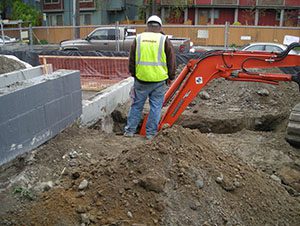During the last wet season, Seattle Public Utilities (SPU) received many reports from the community and other public agencies about turbid (muddy) runoff from construction sites. Construction site operators also notified SPU that runoff was bypassing stormwater treatment system and that there were unanticipated overflows from the sites. Sometimes, the issues experienced at the construction sites impacted the City’s stormwater drainage system, and downstream surface waterbodies. Whenever possible, we want to limit those types of situations to prevent impacts to the environment and to minimize the time and resources spent addressing preventable illegal discharges.
As we approach the next wet season, SPU is offering a few wet-season tips and reminders to Seattle’s construction industry:
- Watch the weather daily!
- Review your site’s erosion control plan and the existing structural and operational best management practices (BMPs).
- Clean/replace/re-position structural controls, as needed, and carry out good housekeeping BMPs.
- Protect catch basins, stabilize soils, and arrange for additional supplies and capacity (e.g., another storage tank).
- Know your site’s designated Certified Erosion and Sediment Control Lead and how to contact them. They should prepare and advise you ahead of, and during, wet weather conditions.
- Anticipate where runoff will travel, identify the impacted stormwater assets (e.g., catch basins), and where the stormwater will discharge (such as a creek, lake, or another pipe).
- Re-familiarize yourself with all the nearby catch basins, culverts, ditches, and other stormwater infrastructure that could be impacted by high flows, overflows (from baker tanks, for example), and runoff.
- SPU’s Water and Sewer Map illustrates drainage infrastructure (select “Sewer & Drainage”), but site construction may have modified the existing conditions. Be sure you know what has changed onsite and where things flow now.
- Re-familiarize yourself on Construction Stormwater Controls (Volume 2 of the City’s Stormwater Manual).
Please Call (206) 684-8860 and request a “grading season extension site meeting” with a site development inspector. The grading season extension becomes effective after your meeting. - Report turbid discharges from the site to Ecology’s Northwest Regional Office (206-594-0000) and SPU’s Operations Response Center (206-386-1800).
- You may identify turbid discharges through observation or through sampling.
- Be ready to share an estimate of the discharge volume, duration, cause, observations, impacted infrastructure and waterbodies, mitigation actions, and a point-of-contact.
